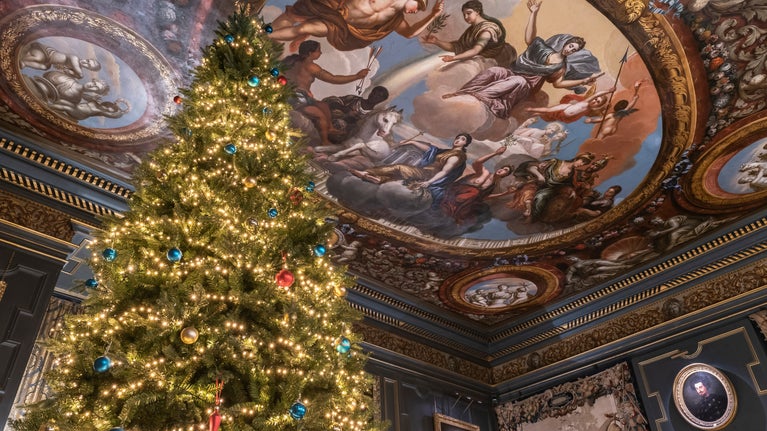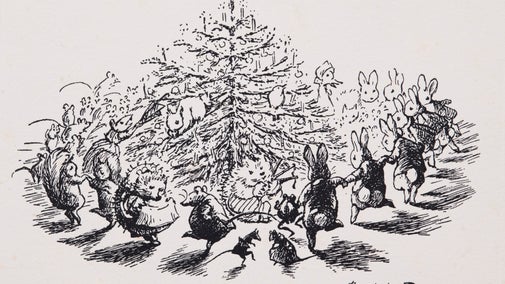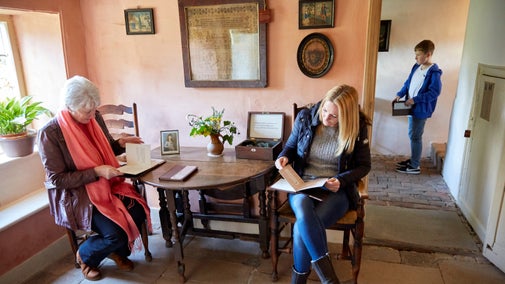
Immerse yourself in history
Meet people from the centuries gone by, learn about the unique artworks in our care and understand more about historic traditions.

Beatrix Potter is best known as the creator of Peter Rabbit and other animal characters. Discover how her middle-class upbringing, fascination with animals and creative flair culminated in a successful career as an author and illustrator. Her passion for conservation existed long before conservation became popular. She left 4,000 acres of land and 15 farms to the National Trust when she died in 1943.
Beatrix Potter was born in London on 28 July 1866 as Helen Beatrix Potter. She lived with her mother Helen, her father Rupert, and her younger brother Bertram.
The families of both her parents had their origins in the industrialised north of England. The money inherited from the Lancashire cotton industry enabled the Potters to live comfortably in Bolton Gardens, an elegant square in Kensington, London.
Rupert Potter was a qualified barrister who chose not to practise his profession but to pursue his passion for art and photography.
As a young child, Beatrix showed signs of having inherited the artistic talent of her parents and was frequently treated to gallery trips or visits to her father’s notable friends: William Gaskell, husband of novelist Elizabeth Gaskell, and painter John Everett Millais.
Typical of many middle-class young girls in the Victorian period, Beatrix had little real contact with her parents.
Her childhood was rather lonely, with few friends and only a governess for company. Her fascination for painting and drawing took up most of her spare time outside lessons and she loved to sketch plants and animals. This interest would later become the inspiration for her stories.
The Potters took long holidays each year to the countryside in Scotland and the Lake District where Beatrix indulged in her interest in nature, spending hours exploring and sketching the wildlife.
Her first visit to the Lake District was in 1882 when she visited Wray Castle, a Victorian Gothic-style mansion. The family also stayed in Lingholm, Fawe Park, Holehird, and Lakefield (now Ees Wyke).
Beatrix frequently returned from holiday with animals such as mice, rabbits, newts, caterpillars and birds, which formed a menagerie in the schoolroom.
Beatrix had been painting for her own amusement for many years but in 1890 she had her first commercial success with rabbit pictures she sold as Christmas card designs to Hildesheimer & Faulkener.
Beatrix had become close friends with her former governess, Annie Moore. She was particularly fond of Annie’s young children, regularly writing amusing picture letters for them about the many pets she kept.
As well as writing books, Beatrix wrote letters to family, friends and fans all over the world. You can buy a book of her published letters to adults and another of her letters to children.
Several years later Beatrix turned one of the tales into a picture book. It was rejected by several publishers, so she privately printed 250 copies of it herself. The Tale of Peter Rabbit was a great success with family and friends.
In 1902, Frederick Warne & Co agreed to publish an initial quantity of 8,000. They sold out instantly and Beatrix’s career as a storyteller was launched.
By 1905, Warne had published six of Beatrix Potter’s books, including The Tale of Mrs Tiggy-Winkle. She used the profits to buy her first farm, 17th-century Hill Top Farm in Near Sawrey village in the Lake District. Along with the surrounding countryside it became the inspiration for many of her subsequent books.
In the summer of that year, Norman Warne proposed marriage and she accepted. But tragically, Norman fell ill and died four weeks later. Beatrix threw herself into the running of her farm whilst working on more ‘little books’. The Tale of Tom Kitten and The Tale of Jemima Puddle-Duck were both set in and around Hill Top.
Beatrix’s love of the Lake District inspired her to create some of her most famous tales. She became a prominent member of the farming community and a fierce campaigner on local conservation issues.
While she was passionate about preserving a way of life, she was an astute and forward-thinking businesswoman, not afraid of making changes where necessary. Beatrix purchased a considerable amount of land in the Lake District and was advised by local solicitor William Heelis who she met in Hawkshead and later married.
She and William lived in Castle Cottage, Near Sawrey, from 1913 until her death. Only a few books were produced for Frederick Warne after their marriage as she became much more focused on farming and investing in land and the local community around Near Sawrey.
– Beatrix Potter in a letter to Eleanor Rawnsley, 1934
Beatrix worked closely with the National Trust, helping it to acquire land and manage farms to ensure their long-term preservation.
Since an early meeting at Wray Castle, Beatrix became a good friend of Canon Hardwicke Drummond Rawnsley – one of the three co-founders of the National Trust. When she died in 1943, she left 4,000 acres of land and countryside in our care, as well as 14 farms. Her legacy has helped ensure the survival of the Lakeland landscape.

Meet people from the centuries gone by, learn about the unique artworks in our care and understand more about historic traditions.
Beatrix Potter's farmhouse retreat: the inspiration for her little books.

Explore the stories behind the illustrations, sketches and letters of this legendary author, preserved by the National Trust at her former home in the Lake District.

As well as a founder of the National Trust, Hardwicke Rawnsley was a religious man, writer, social reformer and active campaigner for the protection of the Lake District.

Find out about the work of Robert Hunter and how his job as a solicitor helped shape the National Trust.

One of three founders of the National Trust, Octavia Hill is among the greatest social entrepreneurs in British history and the impact of her life and work is still felt today.

Learn about the remarkable women in history linked to the places in our care, from the political player who helped make Charles II king, to the archaeologist who discovered a 7th-century Saxon ship burial.

Walk in the footsteps of famous faces. From The Beatles and Sir Winston Churchill, to Agatha Christie and Isaac Newton, step into their former homes and learn more about their lives.
